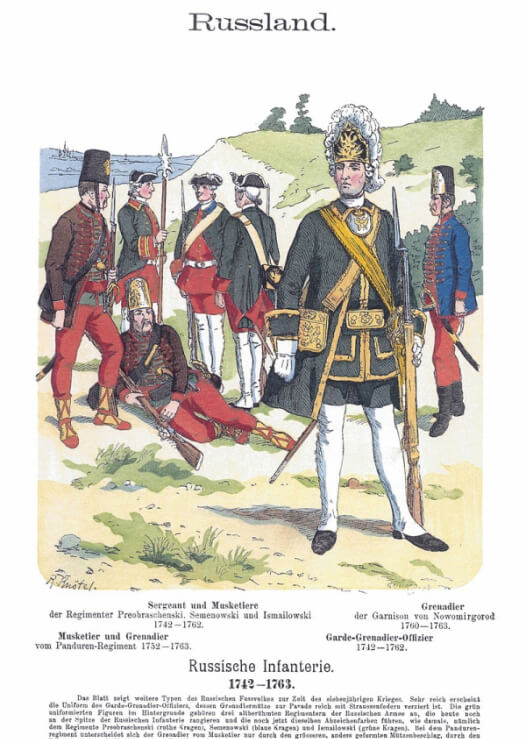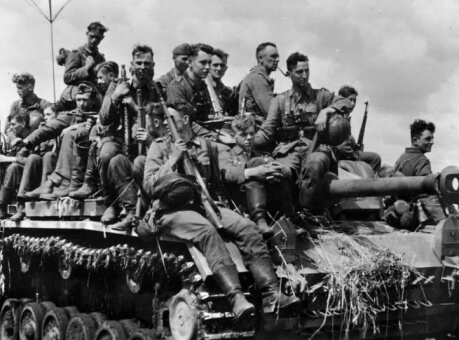Military heraldic symbols – history and continuity
The army is subject not only to orders, but also to fashion trends. Even to a very significant extent: it often does not depend on the relevant order. For example, the officer’s cap in the modern Russian army has not officially undergone any changes. But even people far removed from military affairs have noticed how the huge “aerodrome” suddenly shrank in size, and the tulle barely protrudes beyond the borders of the eyepatch.
Particularly interesting is the history of changes in hairstyles and the wearing of beards in the Russian army. In the pre-Petrine era it was not regulated in any way: the traditional way of life itself presupposed the wearing of moustaches and beards. And it is not just that Peter tried to change the appearance of his subjects in the European manner. This is more of a political moment: the desire to separate the servants from the rest of the population. A sovereign man should be seen at once: a European-cut uniform instead of laptops and shirt and, of course, the absence of a beard. It was under Peter in the Russian army introduced a staff of barbers, who were required to shave the personnel, leaving soldiers only a moustache.

Unlike soldiers, officers of that time tried to do without moustaches, but the fashion of the time obliged them to wear a wig. And a wig of the Petrine era – long, curled, complex design and quite expensive. By the way, wearing wigs was also supposed to be worn by the lower ranks, but, apparently, in those years it was not to them – with a rather poor supply the Petrine army had enough more pressing problems.
During the XVIII century, the wig decreases in size: it becomes quite short already at the time of Anna Ioannovna, and at the time of Catherine II – one or two superimposed bouclés. But, in any case, the wig is obligatory for everyone to wear. This innovation begins, as usual, with the Guard, and gradually it became a mandatory army attribute of both lower ranks and officers. Not only that: it was obligatory to powder the wig – officers used real powder for this purpose, lower ranks successfully made do with ordinary flour. In addition to the wig, a braid was also compulsory: either the hair was grown back and braided, or a superimposed construction with a willow twig at the base was used – naturally, all this was heavily powdered.

There is an opinion that the plait had the function of additional protection of the infantryman’s back from the cavalryman’s sabre blow. In practice, the tactics of using cavalry against infantry in those years was somewhat different. On the battlefield an infantry unit had a rather dense formation: cavalrymen had to crush and disperse it rather than chop it into cabbage. This was quite enough for victory, as the scattered infantry ceased to exist as an organised unit suitable for combat. If the horsemen managed to get through to the enemy’s artillery battery, the gun crews were understandably tried to knock out; ordinary infantry, as a rule, avoided this fate.
The lower ranks were not entitled to beards, nor were officers. As for moustaches, the lower ranks were entitled to them, while an officer of the Catherine era had to be smoothly shaved. A little later, the permission to wear a moustache is given to the officers of the Hussars. Cossack officers were also allowed to wear moustaches, but they did not always use this permission: the Cossack petty officers were gradually integrated into the Russian nobility.

Thus, the absence of a beard allowed to distinguish a military man from other classes, and the moustache – a lower rank from an officer.
The last time a wig with a pigtail in the Russian army was seen in the time of Paul I: being an admirer of Frederick the Great, he wanted the army to look like the Prussian model. Moreover, the model, very outdated even by the standards of the Prussians themselves.
Alexander I, unlike Paul, was not a fan of the old Prussian military traditions. First, the braid became shorter, then appeared a variety of fashionable hairstyles among officers, and after Austerlitz…. Gone forever in the past and bouclés and braids, and then (since 1809) and powder. All these elements become attributes of a retired staff officer of Catherine’s time, finishing his uniform.
As for the moustaches of officers, in the War of 1812 they are worn by many – both in the cavalry and in the infantry: war, field conditions, did not have time to shave…. But only officers of light cavalry, following the hussars, have been officially authorised to wear them so far. In addition, under Alexander I, the fashion for sideburns appeared among officers.




